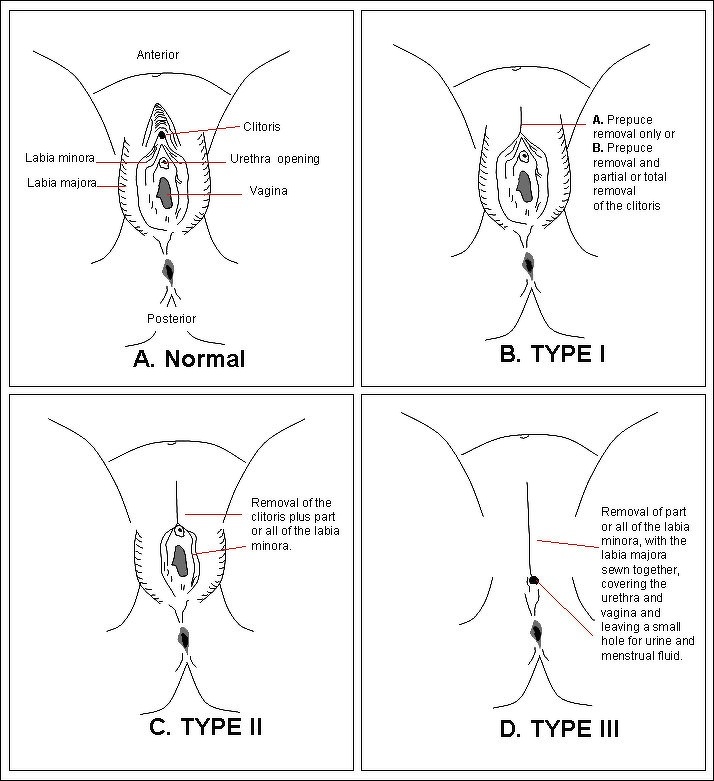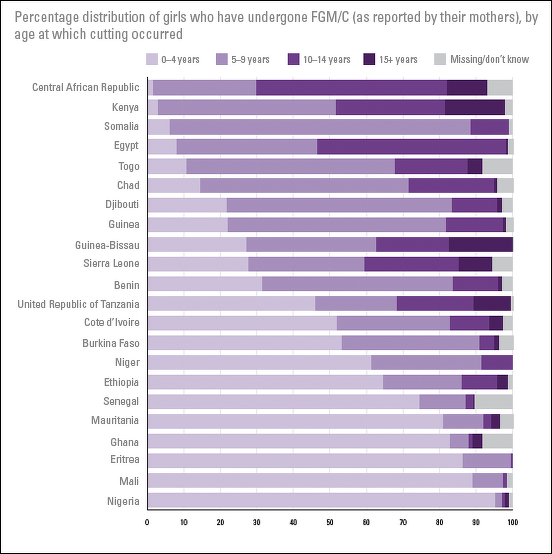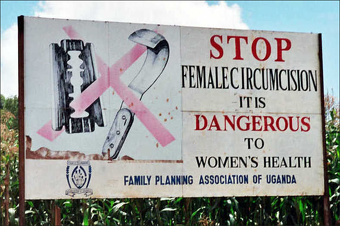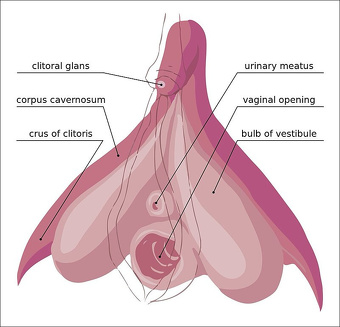Home | Category: Muslim Marriage, Family and Funerals / Muslim Women / Muslim Food, Sex and Drugs / Arab Life, Marriage, Family and Funerals / Arab Women / Drugs, Clothes and Sex in the Middle East
FEMALE CIRCUMCISION
Female circumcision is still performed in some parts of the Middle East, particularly Egypt, and to a lesser degree in Yemen, Oman, Jordan, Syria, Iraq, Saudi Arabia and Muslim Africa but is by no means widely practiced in the Arab-Muslim world. Some Muslim law schools endorse the practice. Many Christians and women in sub-Sahara Africa also have it done. According to this custom, young girls have their clitoris removed, apparently to keep them from enjoying sex and straying from their husbands when they get older. Attempts are being made to eradicate this practice, and even traditionalists say it has no basis in Muslim law.
Female circumcision can range from clipping of the end of the hood (labia minora) of the clitoris to removing the entire clitoris and part of the vagina to amputating the external part of the woman's sex organs. The practice is very common in Africa and performed to a lesser degree in the Middle East. Despite the widespread belief that circumcision is an Islamic ritual, the operation is not performed in most Middle Eastern and Muslim countries. Both Muslim and Christian girls are circumcised and the basis of the custom seems to be cultural rather than religious.
According to the BBC: It is sometimes carried out by a midwife with anaesthetics, but more often than not there is nothing to ease the pain. Another objection concerns the inability of some young women to make a choice. Cutting takes place when a girl is young vulnerable and unable to make an informed decision. In a small village community pressure to take part is enormous.
In some communities Muslim women are being given "dictionaries" by Muslim feminist groups with verses from the Qur’an that help them argue against female genital mutilation and for education for girls. Among other things they learn that defaming a decent women, according to Muslim law, can be punished with 80 lashes. [Amy Schwartz, Washington Post]
Often performed without anaesthetic and the cause of serious infections, the painful operation involves the cutting away of the clitoris of the inner lips of the vagina. The operation is designed to make sex less desirable for female to prevent wives from straying from their husbands. Many women who have had done say it proper.
According to Reuters: Genital mutilation predominantly occurs in 28 African countries, including Sudan, Chad, Sierra Leone and Djibouti, but it also takes place in some Middle Eastern nations, like Saudi Arabia, among immigrant communities in Europe and North America, and parts of Asia, including Indonesia. [Source: Reuters, March 10, 2007]
Female Circumcision — Not an Islamic Practice
Dr. Heba G. Kotb wrote: The issue of female circumcision is summarized in the following points: 1) Female circumcision is a habit practiced long before Islam. Its map of distribution does not coincide with the Islamic map, and includes parts of Russia, some Asian (including some Arab) tribes, parts of South America and the Nile valley (Egypt, Sudan and Ethiopia). Female circumcision is still being practiced by both Non-Muslims and Muslims in these countries. However, at present in Egypt and Sudan only Muslims practice it, (a minority in Egypt and more in Sudan). [Source: “Sexuality in Islam” by Heba G. Kotb M.D., A dissertation presented to Maimonides University, 2004]
2) Female circumcision is not an Islamic requirement. Even the prophetic saying (hadith): "circumcision is sunnah (obligatory) for men and charity (good deeds) for women", was considered non authentic by various sources. In another hadith (which is also considered a weak one, i.e. not highly authentic), the Prophet (PBUH) instructed Omm Atiya, a woman practitioner of circumcision, "Take the minimum, Omm Atiya, and don't exceed it, for this would be more pleasurable for the husband and protective of chastity by satisfying the wife's desire" (narrated by Ibn Majjah). This is taken to refer exclusively to the tribes of that time who would insist on the procedure.
Hereby, I have a personal point of view; this is that this event — if it has really happened — gives a space for the medically-indicated excision of a part of the clitoris in case the girl is having a bigger clitoris than it has to be, which makes her vulnerable to clitoral inflammations and ulcerations, the clitoris being thin skinned and not covered by the keratin of which is constituted the outer layer of the regular skin, but if he had prohibited it absolutely, people having medical indication could have regretted seeking surgical correction, for the prophet had prohibited it frankly by name. Hence, Islam did not recommend or forbid female circumcision (same stand in Christianity and Judaism: both knew it).
3) Female circumcision is not practiced in Islamic countries other than Egypt and Sudan and possibly exists in few others. Women of Mecca, Medina (whose people are the mostly following ones to prophetic ‘sunnah’), Najd, the Persion Gulf, Iran, North Africa, Turkey, Iran, Pakistan, Syria, Lebanon, Palestine, etc are not circumcised. This is an established fact.
4) Female circumcision does not diminish sexual desire, for this depends mainly on psycho-hormonal factors. All circumcision does it to make the woman less able to get satisfaction by the regular ways of foreplay, and this is certainly a frequent cause of marital disharmony and problems, despite the fact that circumcised women could get aroused very naturally on simple informing the husband of the special way he has to follow in order to turn his wife on. The major factor of chastity before marriage and fidelity within it remains to be the conscience and proper Islamic upbringing. There is no evidence whatsoever that the moral standards in Islamic countries which do not have circumcision are lower than in Islamic countries that have it.
5) In view of this, it seems that there is no Islamic basis of making circumcision a requirement for women/Muslim converts or, for that matter, non-converts.
Female Circumcision (Female Genital Mutilation) and Cultural Tradition
According to the BBC: Genital cutting is widespread within some African cultures and ethnic groups. It is seen as the climax of initiation, something that both boys and girls have to take part in before they are accepted as adults in the community. Those opposed to genital cutting prefer to use the term female genital mutilation. some communities the controversial practice is a female rite of passage and remains an important religious and cultural tradition. In regions where a new religion has become dominant, the tradition of genital cutting does not necessarily die out.
“Young people leave home to be trained in the ways of adult life. For girls this means learning practical skills before returning to their homes as women. According to supporters, the process of female genital cutting has practical merits in a physically harsh society. It is proof that the woman is mentally strong and able to deal with the difficult responsibilities of adult life. It also has religious and social significance. The shedding of blood is seen symbolically as a stream connecting the woman to the rest of her close-knit community. In a small community oneness is very important. |::|
“The ritual is also seen as an essential preparation for marriage. After the initiation rituals women begin looking for a husband and hope to start a family. Even in the United States, 10,000 girls are believed to be at risk from illegal operations within their own communities. It has also been reported that young women in Australia, Canada, Denmark, France, Italy, the Netherlands, Sweden and the UK have also undergone similar operations.” |::|

Female Circumcision in Egypt
In the 1990s, an estimated 70 to 90 percent of all Egyptian women and girls have been circumcised. Officials were stunned by a government survey that found that 97 percent of married women between 15 and 45 have been circumcised. Among women with daughters, 87 percent reported that at least one girl had been circumcised or would be. Until the procedure was banned in 1996, health officials estimated that approximately 250,000 female circumcisions were performed every year. [Source; Caryle Murphy, Washington Post, August 28, 1994]
Female circumcision in Egypt received international exposure in September 1994 when CNN videotaped a barber, assisted by a plumber, performing a circumcision on a screaming 10-year-old girl. The two men plus the girl's father were later arrested by police.
Some scholars believe that Egyptian women have been getting circumcised since Pharonic times. Some Islamic clerics say there is a saying in the Qur’an that justifies it. Most Egyptian claim the practice is not done for religious reasons. One woman told the Washington Post, "My mother was ignorant and stupid. They just did it because everyone else did. One generation gave it to the next generation. That's just how it was."
Beliefs About Female Circumcision
Some parents in Egypt believe their daughters will become prostitutes if they are not circumcised even though most Egyptian prostitutes are themselves circumcised. An uncircumcised girl is supposed to be "very hot" and many parents believe she will have difficulty finding a husband. A mother told Washington Post reporter Caryle Murphy that she insisted her 14-year-old daughter be circumcised because "it had to be done, because a woman cannot be like a man. And if I don't, my daughter will get sexually excited."
"Women have to be circumcised," one woman told Murphy, "so they can feel their femininity in Egypt. So she feels that she's a woman." Another woman said that an Egyptian wife "has to be very reserved, a lady."
On female circumcision, one Egyptian cleric said: "It prevents diseases like AIDS and bad smells. It makes the woman control her sexual urges." Another said, unless a girl is circumcised, wearing tight clothes "will make her want any man, any boy, for sex." One cleric at Cairo’s respected Al Azhar university said that "girls who are not circumcised have a sharp temperament and bad habits.

Female genital mutilation map
Painful Female Circumcision Medical Procedure
Female circumcision usually involves the cutting or removal of the clitoris. This area of the genitals is very sensitive because it contains the most nerve endings. The side effects of female circumcisions include infection, uncontrolled bleeding, anemia, painful intercourse, problems in childbirth, infertility and reduced sexual desire. Hospitals, the Washington Post reported, "regularly admit girls in shock from hemorrhaging after botched operations.
Genital cutting is a painful practice that is often poorly carried out, and endangers the health and lives of millions of girls, particularly in Africa. Girls have died from bleeding, seizures, infections and other causes. In 1996, two girls died at the hands of the same doctor on the same day. One who was only four years old died of complications with the anesthesia. "When I did my two eldest daughters," a woman told Murphy, "It was four days of torture. They were crying and in pain for four days."
According to the BBC: “The operation involved varies widely from culture to culture. In its most extreme form (infibulation) it can involve the removal of all external genitalia and the stitching up of the labia leaving only a very small opening for sex, urination, menstruation and giving birth. This often makes a later operation necessary to create a larger opening. Many objections to the practice of genital cutting are concerned with the particular circumstances in which it is done. Amnesty International, a human rights organisation, reports that the operation is often carried out using blunt tools (penknives, fragments of glass or tin cans). A particularly brutal operation can leave a woman with haemorrhaging, infections, abscesses and sometimes a lifelong loss of sensation during sex. The Pan-African Committee on Traditional Practices estimates that two million girls in Africa each year undergo some kind of genital cutting which endangers both their health and their lives.”
One Family Planning official said that she is concerned about the psychological scars of the operations. "When they hold [a girl] down to do this circumcision, she gets a complex. She remembers the day always. She has bleeding and sexual problems. “

Types of Female Genital Mutilation
Female Circumcision Medical Procedure in Egypt
The female circumcision operation in Egypt is usually performed by a barber or midwife while the surprised girl is held down by relatives when she is between the ages of 4 and 12. Occasionally three years olds endure the procedure. These days, more mothers take their daughters to a doctor for the operations. There the girls get "total anesthesia" and the circumcision is "more comfortable," the instruments are clean, and the bleeding is controlled.
Many mothers however still take their daughters to midwives. The operation performed by a midwife with a barber's razor and can of anesthetic spray cost around $7 in the 1990s. According to ancient custom, the excised pieces are dipped in salt and wrapped around the girl’s arm in a cloth. After seven days the pieces are thrown in the Nile. "If you throw them anywhere else, she won't have children," a mother said.
One Egyptian woman told Murphy she spared her two daughters from the operation because a circumcised woman "hates to have her husband lie with her...and this may mean many troubles. This is very important, for the woman to be happy with her husband and not hate this meeting. Grandparents sometimes steal their granddaughters away from their mothers on the weekend and have operations performed without the mothers knowing about it.
Laws Against Female Circumcision in Egypt
In the 1950s, the Egyptian government tried to stop midwives from performing the custom, while allowing doctors to do so - fearing that otherwise families who insisted on circumcising their daughters would have the operation carried out in unsafe conditions. But in 1996, the health minister imposed a total ban on the practice.
In July 1996, a law was passed in Egypt that made female circumcision illegal. The law banned all female circumcisions: those performed in hospitals and clinics by doctors and those performed with razor blades in backrooms by midwives and barbers. Under the law, doctors and hospitals that perform female circumcisions can have their licenses revoked.
Some doctors criticized the decision on the grounds of health and basic rights. "Doctors know ethically this is not to be done," a physician told Murphy. "But their answer is that they are saving girls from being mutilated by midwives and barbers. If a doctor cuts the clitoris legally he is committing a crime. But this is not enforced. Enforcing the law is impossible."
In June 1997, an Egyptian court overturned the decree than banned female circumcision. Islamic leaders celebrated the decision while human rights advocates were disappointed. The decision removed the ban on circumcisions performed by doctors but maintained the ban on circumcisions performed by midwives and barbers, which had been in effect before the July 1996 ruling.
In 1998, the July 1996 ban on all female circumcisions was upheld by the Supreme Administrative Court on the grounds that Islam does not demand the operation, which gives the government the right to demand a ban on the procedure if they want. The ruling was final and could not be appealed.
Female circumcisions continue to be done. The enforcement of the ban is considered lax. The practice has gone underground where its more likely to be done by midwives and barbers because if they get caught they don't have as much to lose as doctors.

age range of female genital mutilation by country
Muslim Scholars Rule Female Circumcision Un-Islamic
A Egyptian conference of Muslim scholars from around the world declared female circumcision to be contrary to Islam and an attack on women, and called today for those who practice it to be punished. Associated Press reported: “The conference, organised by the German human rights group TARGET, recommended that governments pass laws to prohibit the tradition and that judicial bodies prosecute those who mutilate female genitals. "The conference appeals to all Muslims to stop practicing this habit, according to Islam's teachings which prohibit inflicting harm on any human being," the participants said in their final statement. [Source: Associated Press, November 24, 2006]
Egypt's two top Islamic clerics, Muhammad Sayed Tantawi, the Grand Sheik of Al-Azhar, the foremost theological institute in the Sunni Muslim world, and Grand Mufti Ali Gomaa, attended the conference, which drew scholars from as far afield as Russia. Tantawi's and Gomaa's edicts are considered binding.
Female circumcision continues to be practiced in many places despite numerous campaigns against it. Those men who support the tradition believe it lowers a girl's sexual desire and helps maintain her honour. They also believe it is required by Islam. The scholars said circumcision inflicts physical and mental harm on women. Furthermore, they said, Islam considers it to be an aggression against women. Those who perform it should be punished. "The conference reminds all teaching and media institutions of their role to explain to the people the harmful effects of this habit in order to eliminate it," the scholars said in their recommendations.
"The conference calls on judicial institutions to issue laws that prohibit and criminalise this habit ... which appeared in several societies and was adopted by some Muslims although it is not sanctioned by the Quran or the Sunna," the scholars said, referring to Islam's holy book and the sayings and deeds of Prophet Muhammad. Although many countries have outlawed female circumcision, the law is poorly enforced and prosecutions are rare.
Image Sources: Wikimedia Commons
Text Sources: “Sexuality in Islam” by Heba G. Kotb M.D at Archive for Sexology sexarchive.info; National Geographic, BBC, New York Times, Washington Post, Los Angeles Times, Smithsonian magazine, The Guardian, BBC, Al Jazeera, Times of London, The New Yorker, Time, Newsweek, Reuters, Associated Press, AFP, Lonely Planet Guides, Library of Congress, Compton’s Encyclopedia and various books and other publications.
Last updated March 2024


